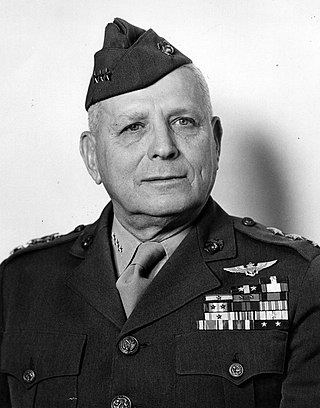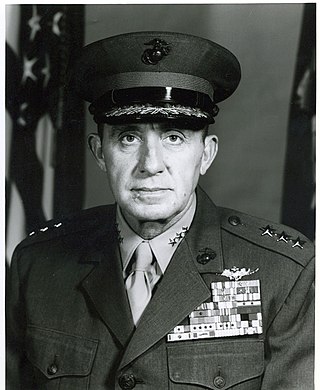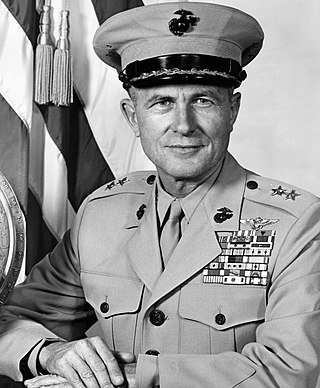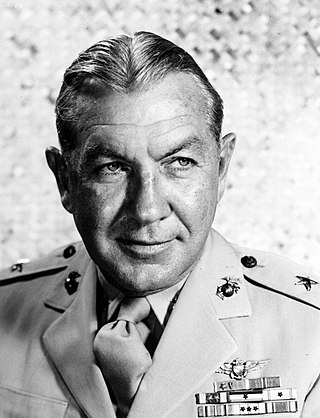
Roy Stanley Geiger was a United States Marine Corps four-star general who served in World War I and World War II. In World War II, he became the first Marine Corps general to lead a field army.

Christian Frank Schilt was an American general in the U.S. Marine Corps. He was one of the first Marine Corps aviators and a recipient of the United States highest military decoration, the Medal of Honor. He received the Medal for using his biplane to evacuate wounded Marines under fire in Nicaragua.

Keith Barr McCutcheon was a highly decorated Marine Corps four-star general and aviator seeing combat in World War II, the Korean War, and the Vietnam War. He earned the Distinguished Flying Cross and ten Air Medals.

John Kerry Davis, also known as J.K. Davis, was a United States Marine Corps four-star general. Davis, a Vietnam War veteran and naval aviator, served as the Commanding General of the 3rd Marine Aircraft Wing (1977–1978) and the 1st Marine Aircraft Wing (1978-1978). His final assignment was as the Assistant Commandant of the Marine Corps from July 1, 1983, to June 1, 1986.

General Vernon Edgar Megee was a United States Marine Corps general. He is recognized as a pioneer in the development of close air support for ground combat operations. He served as Assistant Commandant of the Marine Corps from 1956 to 1957; with his final billet from 1957 to 1959 as commanding general, Fleet Marine Force, Pacific. When he retired from the Marine Corps, after 40 years of active duty service, he received a promotion to 4-star rank.

Louis Bentham Robertshaw was an American football player and lieutenant general in the United States Marine Corps. He flew combat missions in World War II and the Korean War and flew an F4B Phantom II fighter in the Vietnam War as commanding general of the 1st Marine Aircraft Wing. He received three Distinguished Flying Crosses, 12 Air Medals, the Navy Distinguished Service Medal, and three Legion of Merit with Combat "V."

Avery Raymond Kier was a United States Marine Corps aviator and general officer. During World War II he served as the commanding officer of VMSB-234 and towards the end of the war was a pioneer in the development of close air support for ground combat operations serving at both Iwo Jima and Okinawa. Following WW II, Kier served as the commanding officer of numerous Marine aircraft groups, air stations and air wings, with his last assignment being that of deputy commander for Fleet Marine Force, Pacific. He retired from the Marine Corps on 1 March 1967.

Ford Ovid Rogers was a highly decorated naval aviator, who served with the United States Marine Corps, retiring with the rank of major general. He was decorated with the Navy Cross for his World War I service and received a Legion of Merit and a Distinguished Flying Cross for service in World War II.

Lieutenant General James Tillinghast Moore was a decorated Officer and aviator in the United States Marine Corps, he is most noted for his service as commanding general of the 2nd Marine Aircraft Wing during World War II.

Francis Butler Loomis Jr. was a decorated officer of the United States Marine Corps, who reached the rank of major general. He is most noted as executive officer of the 1st Defense Battalion during the Shelling of Johnston and Palmyra and later as Logistic Officer of III Marine Amphibious Corps during Battle of Okinawa. He was the son of United States Assistant Secretary of State, Francis B. Loomis.

Albert Dustin Cooley was a highly decorated Naval aviator of the United States Marine Corps, who reached the rank of lieutenant general. For his actions during the Battle of Guadalcanal, he received the Navy Cross, the United States military's second-highest decoration awarded for valor in combat. Cooley completed his 33-year Marine Corps career as commanding general of the 1st Marine Aircraft Wing.

Stanley Emanuel Ridderhof was a highly decorated naval aviator of the United States Marine Corps with the rank of brigadier general. A veteran of many conflicts, Ridderhof enlisted in the Marine Corps during World War I and received commission soon after. He then served in Nicaragua and received Navy Cross, the United States military's second-highest decoration awarded for valor in combat. During World War II, he served various assignments in the Pacific theater and received Distinguished Flying Cross and other decorations.

Richard Edward Carey is a retired United States Marine Corps Lieutenant General.

Robert Prescott Keller was a highly decorated Naval aviator in the United States Marine Corps with the rank of lieutenant general. He began his career as reserve pilot during World War II; he shot down one enemy aircraft and damaged two others during New Britain campaign. Keller distinguished himself again as pilot during Korean War and later reached general's rank during Vietnam War.

Hugh McJunkin Elwood was a highly decorated flying ace in the United States Marine Corps during World War II. A veteran of three conflicts, he remained in the Marines and reached the rank of lieutenant general. Elwood completed his career as deputy chief of staff in 1973 after 40 years of service.

John Pomeroy Condon was a highly decorated aviator in the United States Marine Corps with the rank of major general. He distinguished himself successively during World War II and Korea and completed his career as commanding general, 3rd Marine Aircraft Wing in October 1962.

Ralph Kaspar Rottet was a decorated officer and naval aviator in the United States Marine Corps with the rank of lieutenant general. A veteran of World War II, where he distinguished as commanding officer, Marine Aircraft Group 31, he later rose to through the ranks and completed his career as Deputy Chief of Staff for Plans and Programs at Headquarters Marine Corps in 1968.

George Shepard Bowman Jr. was a decorated officer and Naval aviator in the United States Marine Corps. A veteran of three wars, Bowman distinguished himself several times as commander, Marine Aircraft Group 12 in Korea and later rose through the ranks to major general and commander of 2nd Marine Aircraft Wing.

Homer Spurgeon Hill was a decorated naval aviator in the United States Marine Corps with the rank of major general. A veteran of three wars, Hill began his career as a reservist and pilot of transport planes, participating in combats in Pacific theater.

David Ferguson O'Neill was a decorated Naval aviator and officer in the United States Marine Corps with the rank of major general. A veteran of World War II, he commanded Strike Command, Aircraft Solomons on Guadalcanal, New Britain and Bougainville and received several decorations for his service.






















